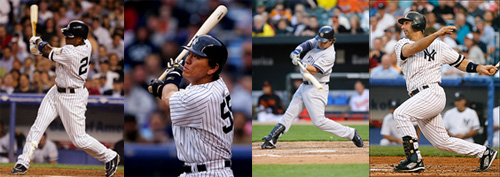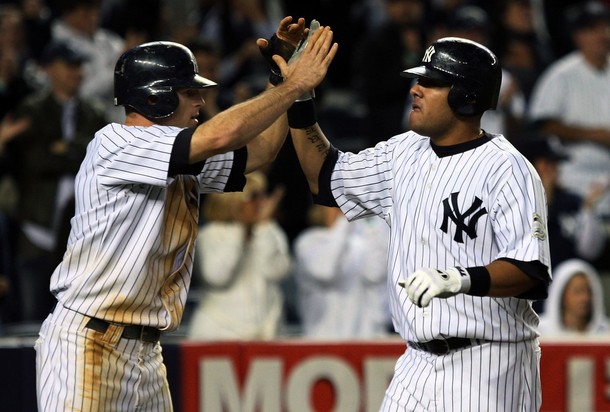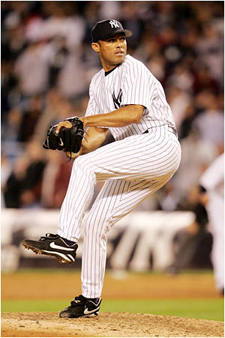Over the next week or so, we’ll again break down what went wrong and what went right for the 2009 Yankees. The series this year will be much more enjoyable than the last.

At this time last year, the Yankees roster was anything but set. They had a huge offer out to CC Sabathia, and planned to pursue at least one other starting pitcher. That would help shore up the rotation, but clearly there were no guarantees. On top of that, the Yankees powerhouse offense went out with a whimper in 2008. Not only did the Yankees need another bat to enhance the offense, but they’d need contributions from players who underperformed in 2008.
With the acquisition of Nick Swisher, the Yankees had four players who underperformed in 2008. Jorge Posada and Hideki Matsui missed much of the season with injuries, and Robinson Cano and Nick Swisher had poor seasons at the plate. Even with the potential addition of Mark Teixeira, the Yankees had a lot to worry about. Without contributions from at least two of those four, the Yankees offense wouldn’t have been nearly as formidable.
Two of four didn’t seem like asking a lot. Two of the players in question were proven veterans coming off injuries, and other two were players in their primes who each had a bad season. But as it turned out, all four bounced back. That turned out to be a key to the 2009 season. It meant the Yankees had above average contributors in eight out of nine lineup slots, with the final filled by an average player. How many other teams can boast of such a powerhouse?
Here’s how the Yankees in question performed in 2008, and how they bounced back in 2009. All stats are from FanGraphs, at risk of Jeremy Greenhouse calling me out.
| Player | 08 wOBA | 08 WAR | 09 wOBA | 09 WAR |
|---|---|---|---|---|
| Jorge Posada | .340 | 0.8 | .378 | 4.0 |
| Hideki Matsui | .348 | 0.8 | .378 | 2.4 |
| Nick Swisher | .325 | 1.0 | .375 | 3.5 |
| Robinson Cano | .307 | 0.5 | .370 | 4.4 |
Both Swisher and Cano both returned to their pre-2008 forms, which brought a huge boost to the offense. As you can see from the table, these were not insignificant improvements. Not only did they increase rate production over 2008, but they stayed healthy and therefore added that value over the course of the season. WAR favors Cano over Swisher by almost a full run, but that’s mostly because of the positional adjustment. Both had phenomenal seasons, especially compared to 2008.
Posada and Matsui contributed in two ways. First, they improved their net production over 2008. Even when healthy, Posada and Matsui weren’t quite where they had been in years past. Their wOBA numbers weren’t bad in 2008, but the Yankees have seen them perform much better. There was certainly fear that age had caught up with them, but they answered that charge by coming back to produce in 2009. That leads to the second part of their improvement, remaining healthy. Even with their production in 2008, they didn’t help the team as much because they were hurt for much of the season. In 2008 both stayed healthy enough to add a ton of value to the team, as evidenced by their WAR figures.
All four players certainly had the potential to bounce back after poor 2008 campaigns. Cano and Swisher were guys in their primes who had bad years, and Matsui and Posada were two veterans who faced injury struggles. During the 2008-2009 off-season, it would have been wildly optimistic to predict that all four would bounce back. The Yankees got lucky in that regard. All four contributed to the 103-win season, which set up the team’s run through the playoffs. The 2009 Yankees might have made the playoffs if only two of those four bounced back, but they wouldn’t have been nearly as dominant. While the improved pitching staff was a big part of the story this season, we shouldn’t overlook Posada, Matsui, Cano, and Swisher. Their contribution was a big part of making this season as special as it was.


 We are truly blessed. For the past 13 years, we’ve had the privilege of watching Mariano Rivera work his magic out of the bullpen. While he may never hold the career record for saves, he is the greatest relief pitcher in the history of baseball. You won’t find too many people, Yankee lover or hater, who will argue that point. In an aspect of the game wrought with volatility, Mo has been a pillar of consistency and excellence.
We are truly blessed. For the past 13 years, we’ve had the privilege of watching Mariano Rivera work his magic out of the bullpen. While he may never hold the career record for saves, he is the greatest relief pitcher in the history of baseball. You won’t find too many people, Yankee lover or hater, who will argue that point. In an aspect of the game wrought with volatility, Mo has been a pillar of consistency and excellence.